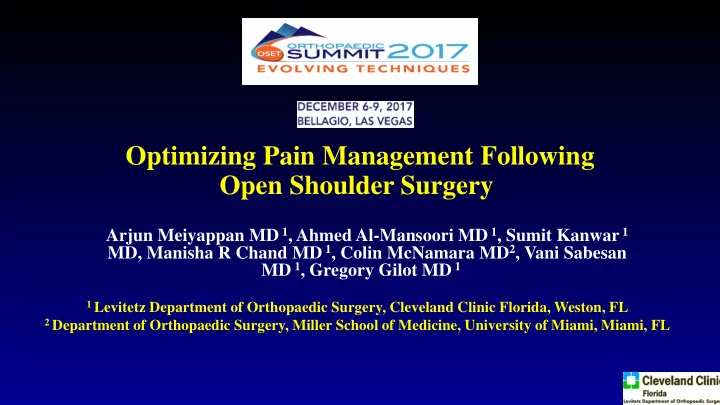

Optimizing Pain Management Following Open Shoulder Surgery Arjun Meiyappan MD 1 , Ahmed Al-Mansoori MD 1 , Sumit Kanwar 1 MD, Manisha R Chand MD 1 , Colin McNamara MD 2 , Vani Sabesan MD 1 , Gregory Gilot MD 1 1 Levitetz Department of Orthopaedic Surgery, Cleveland Clinic Florida, Weston, FL 2 Department of Orthopaedic Surgery, Miller School of Medicine, University of Miami, Miami, FL
An Opioid Crisis Shoulder Arthroplasty One of the Most Painful Ambulatory Surgeries Requires Substantial Post-operative Pain-management Postoperative Pain Usually Controlled with Narcotics Opioid Addiction – An Epidemic in the US
Objectives To determine which pain management protocol is most efficient at reducing the use of narcotics after surgery
Liposomal Bupivacaine A novel non-opioid-based medication created for postoperative pain management for a multitude of orthopedic procedures Bupivacaine coated in Liposomal vesicles
Methods A Prospective Clinical Trial of 47 Patients Who Underwent TSA, RSA or ORIF We looked at three different pain management systems for post-operative pain
Methods Patients Were placed in 3 Groups: • Periarticular Liposomal Bupivacaine (LB) Group 1 (N=17) • Intra-articular Bupivacaine pump (pain pump-PP) Group 2 (N=16) • Periarticular Free Bupivacaine (FB) Group 3 (N=14) Outcomes Compared: Visual Analogue Score (VAS) Total Morphine Equivalents (TME) Opioid Related Symptoms Distress Scale (OR-SDS)
Demographics Our cohorts were matched for for Age, Gender, BMI and ASA Class
Results 24 hours No significant differences were found between the three groups at 1 day postoperatively based on VAS pain score and TME usage VAS TME p=0.86 P=0.12 10 60 53.05 51.82 9 50 46.63 8 7 40 6 5.18 4.78 30 5 4 3.11 20 3 2 10 1 0 0 Liposomal Bupivacaine Free Bupivicaine Pain Pump Liposomal Bupivacaine Free Bupivicaine Pain Pump
Results 48 hours At 2 days postoperatively a significant difference was seen in VAS scores On post hoc analysis LB (3.2) was lower when compared to the Pain Pump (5.3) and FB (5.7) VAS TME 10 60 9 50 8 40.2 39.7 7 40 5.7 34.3 6 5.3 MEQ 5 30 4 3.2 20 3 2 10 1 0 0 Liposomal Bupivacaine Free Bupivicaine Pain Pump Liposomal Bupivacaine Free Bupivicaine Pain Pump
Results 72 hours VAS scores also showed a significant difference in the third post-operative day. A post hoc analysis showed LB had a lower VAS score 2.5 when compared to the pain pump 5.1 and FB 5.1 groups VAS TME 60 10 9 50 8 7 40 32.2 31.8 6 5.1 5.1 30 5 30 4 2.5 20 3 2 10 1 0 0 Liposomal Bupivacaine Free Bupivicaine Pain Pump Liposomal Bupivacaine Free Bupivicaine Pain Pump
OR-SDS No Significant Differences At All Points in Time Measured (p > 0.05)
Conclusions Liposomal bupivacaine demonstrated lower pain scores at both 2 and 3 days postoperatively
Conclusions However even with these lowered pain scores narcotic consumption did not differ between the groups as a result Thus There was no significant benefit seen from the use of LB in opioid reduction post shoulder surgery
THANK YOU
Recommend
More recommend